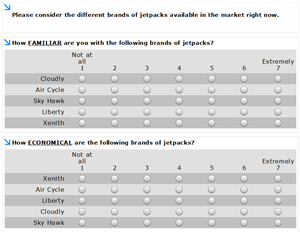You’re an established brand and are looking to make sure your company is positioned correctly in the marketplace. You have an idea of what distinguishes you from competing brands, but aren’t sure whether your customers view your brand the same way. How do customers perceive the marketplace? What brand personality attributes are the most important for distinguishing between brands? How do these attributes relate to each other? Most importantly, is your brand positioned correctly to accentuate your company’s strengths relative to your competitors? Brand Perception Mapping can be used to address these questions.
How it works
Brand Perception Mapping asks survey respondents to complete a personality test of sorts with your brand, alongside other brands in the marketplace. For example, they may be asked how “innovative” the listed brands are, followed by “reliable”, “great bargain”, and so on. It’s important to include actionable personality traits that are relevant to your brand.
A potential concern when collecting feedback is the respondents’ familiarity with the brands in question. It’s strongly encouraged to use “familiar” as one of the brand personality traits for this reason. Answers can be trimmed post-hoc to only include feedback from those respondents who are familiar with a brand.
It isn’t necessary to be familiar with the brand for the methodology to work, however. The technique can also be used in branding and marketing research to test how a message will be received. For example, consider two restaurant names, “Jiffy Eats” and “The Savor”. Which restaurant sounds more concerned with taste and quality? Which name conveys speed and convenience?
Pros:
-
Brand Perception Mapping is an excellent way to see at a glance how customers perceive the marketplace, such as which brand personality traits are the most important for distinguishing between brands, and how those attributes relate to each other.
-
This method can potentially uncover holes in the market. Positioning your brand in such a way that it is perceived as unique ensures that you will minimize competition in the minds of prospective customers. Multiple Brand Perception Mapping studies over time can be used to track the effectiveness of marketing campaigns to see in the personality of your brand is changing in the mind of your customers.
Cons:
-
There are, however, a few notes of caution when using this methodology and interpreting the results. The importance of specific brand personality traits are only relative to the other traits being tested. It’s possible that an untested adjective describing the brands in question could be more important or definitive for distinguishing between brands. Because of this, it’s recommended to interview end users beforehand to objectively learn what words or phrases they would use to describe the brands in question.
-
Identifying important personality traits for distinguishing between brands in the marketplace may not be the whole story. The traits tested aren’t necessarily important to consumers when making a purchase decision. Other aspects of the product, such as price or specific features offered, might be valued more highly by customers than the perceived differences in brand personalities.
-
Finally, once a potential hole in the marketplace is identified, repositioning the brand depends on the marketing claims being believable, yet it might not be possible to move brand perception as desired. For example, regardless of marketing, it’s unlikely that a fast food restaurant would be perceived as fine dining, even if there is a hole in the marketplace for fast, convenient, affordable, fine dining restaurants.
